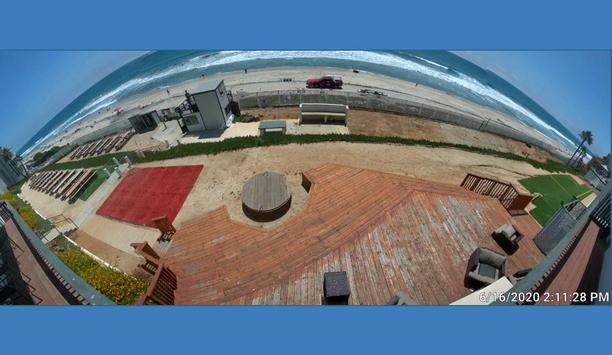Hanwha Vision (formerly Hanwha Techwin Co. Ltd.) - Experts & Thought Leaders
Latest Hanwha Vision (formerly Hanwha Techwin Co. Ltd.) news & announcements
Wilson Bank & Trust, member FDIC, is an independent, community-based bank that began operating in Tennessee, USA in 1987. They have mortgage offices, operations centres, ATMs and branches located in and around Middle Tennessee that serve the city and surrounding rural areas. In total, they have operations and security at approximately 40 locations. One of the keys to their on-going success is their continuous search to improve their offerings. This drive extends to their physical security as well. Starting in 2016, the Bank began to look at upgrading their physical security system with a particular focus on replacing their analog cameras. Upgrading Wilson Bank & Trust’s physical security system The bank had cameras from multiple manufacturers on multiple systems" According to Elvis Huff, the Assistant Vice-President and Director of Security at Wilson Bank & Trust, “The bank had cameras from multiple manufacturers on multiple systems. Most of them were already 8-10 years old, when we began the process.” He adds, “This meant that the image quality was low and we could not get the video retention rates we wanted. In addition, many of the cameras had licensing agreements, so we were paying fees for products that were not meeting our needs.” IT-based, PoE (Powered over Ethernet) cameras Elvis Huff, whose experience prior to joining the Bank includes 12-years in law enforcement, established clear selection criteria at the beginning of the process. The Bank wanted IT-based, PoE (Powered over Ethernet) cameras that could produce high-quality video and did not require licenses. They also wanted DVRs or NVRs that would give them longer-term retention rates, 90-days at a minimum. After investigating their options, Wilson Bank & Trust determined that working with Hanwha Techwin cameras and systems would be the best fit for their requirements. Cyber security as a key consideration During the decision-making process, one of the deciding factors was that Hanwha cameras and systems are manufactured in-house end-to-end. In their view, this was particularly important for mitigating cyber security risks. According to Elvis Huff, “At the time, cyber security and network security issues were frequently reported, as cameras were being compromised for use in Distributed Denial of Service (DDoS) attacks. The ability to work with a company that does everything from manufacturing the chipset and camera to developing the software was a game-changer for us. We knew it would give us tremendous peace of mind.” Multi-sensor panoramic and network IR dome cameras They have taken a multi-year approach to satisfy budget and personnel constraints The bank began with a preliminary test at a single location. According to Elvis Huff, “We tested it for about a month and we loved it. The system was easy to deploy and easy to navigate.” Following this, they began upgrading their physical security systems at several branches, ATMs and other locations each year. They have taken a multi-year approach to satisfy budget and personnel constraints. Till date, they have installed new NVRs and more than 600 cameras. Installation and maintenance cost savings By switching to industry standard PoE, IP-based cameras, the bank has realised significant savings with regards to installation and maintenance costs. “We have reduced our installation costs because we do not have to run extra wire. And, we have reduced maintenance costs because the system is less complex and is less likely to breakdown,” explained Elvis Huff. Upgrading the branches has included the installation of several panoramic cameras and network IR dome cameras. PNM-9020V multi-sensor 180-degree panoramic camera The PNM-9020V multi-sensor 180-degree panoramic camera provides up to 30fps at full resolution. These cameras are a favourite of Huff’s for their ability to capture good quality images of a large area. Elvis Huff adds, “I like that I can put them on the side of a building and capture what is going on in an entire parking lot.” Huff has also installed cameras to record parking lot entrances and exists. Recently, this strategy helped as the security team was able to identify a vehicle associated with a fraud case, by using an image of its licence plate captured, as it was leaving the facility. Dome cameras installed For branch and building interiors, they installed a variety of dome cameras, including the QND – 6010R Network IR For branch and building interiors, they installed a variety of dome cameras, including the QND – 6010R Network IR. This indoor camera provides 2MP maximum resolution, 30fps at all resolutions, motion detection, as well as tampering and defocus detection. According to Elvis Huff, “When it comes to capturing images of vehicles, licence plates and transactions, the directional dome cameras cannot be beat.” Capturing high-quality images with hidden cameras The bank has also made use of the XNB-H6241A Network ATM Camera Kit with 8m cable. Elvis Huff has used the kits to install hidden 2MP HD cameras. The fact that the cameras do not disrupt a branch’s aesthetics is important for maintaining a positive customer experience. At the same time, these kits have allowed the bank to capture images that are not possible with a traditional top-down view. Waist-up images, which include a person’s face, can be vital, when it comes to investigating or prosecuting theft and fraud. Having access to images from this angle is already proving to be invaluable. In a recent case of fraud involving identity theft, an individual presented fictitious and forged documents at one of the bank’s branches. “Thanks to the Hanwha high resolution camera, we had a clear image that we were able to use to identify the individual,” said Elvis Huff. Meeting required retention rates with XRN 2011 NVR Each location has a similar setup with cameras connected to a dedicated NVR Each location has a similar setup with cameras connected to a dedicated NVR (network video recorder). At this point in the process, the majority of the NVRs are XRN 2011s. The XRN 2011 NVR supports up to 32 channels and has a maximum internal storage capacity of 48 terabytes. According to Elvis Huff, the ability to store such a large amount of data was an important factor in selecting the XRN 2011 NVR. He said, “It is not uncommon for us to have a 40 to 50 terabyte NVR as this allows us to meet our 90-day retention requirements.” Video used for investigative purposes Elvis Huff also appreciates the fact that the new NVRs send security personnel notifications, when a camera goes down or if storage issues arise. The video captured is used mostly for investigative purposes. Because their NVRs notify them in the event of an error or potential concern, the team can rest assured that they are continuously capturing the information they need to keep the bank secure. According to Elvis Huff, the relationship with Hanwha Techwin has been a positive one. The bank is happy with the upgraded technology, and Huff continues to be impressed with the equipment, stating “We really like our cameras. We have already seen good returns on the money we have invested. They are proving very beneficial in helping us serve our customers and prevent loss at Wilson Bank & Trust.”
Hanwha Techwin America, a global supplier of IP and analogue video surveillance solutions, has announced that Army and Navy Academy, a college preparatory military boarding school in California, has upgraded its security infrastructure with Hanwha security cameras. Located on a 23-acre beach-front property, the Army and Navy Academy is home to more than 300 students and employs more than 140 faculty and staff members. Two-fold surveillance upgrade According to Jeffrey Gibson, a system with analytics to keep a close watch on the campus could act as a force multiplier With a commitment to continuously adapt and improve, the Academy developed a strategic plan that focused on supporting the long-term success of their cadets. When the school began building and renovating facilities, they included an upgrade to their technology and physical security system. With a two-fold approach, the school first needed to replace their existing, out-of-date analogue camera system. Second, they needed a system that could keep up with current technology. According to Jeffrey Gibson, Assistant Commandant, Operations, Safety, and Security at the Academy, a system with analytics to keep a close watch on the campus could act as a force multiplier. Hanwha security cameras with Wisenet WAVE deployed After an extensive vetting process, the school deployed a video surveillance solution comprised of Hanwha cameras integrated with Wisenet WAVE, a highly customisable and reliable IP-based video management system (VMS). Integrating the Hanwha security cameras using the Wisenet WAVE IP-based VMS made it possible to create a video surveillance solution that was exclusively tailored to the campus’ specific needs. The Academy was able to quickly train security personnel as required, considering the WAVE video management system (VMS) is extremely intuitive and easy to use. Multi-sensor, multi-directional PTZ cameras installed The Army and Navy Academy now has a total of 141 cameras, including PNM-9081VQ multi-sensor, multi-directional cameras for covering wide areas, which allows them to use fewer cameras while seeing more. They have also installed PNM-9320VQP multi-sensor, multi-directional PTZ cameras for zooming in and for covering long distances. Additionally, to be able to effectively monitor between buildings and cover their coastline, the Academy chose PNM-9020V multi-sensor 180° cameras. In-camera and VMS analytics features By taking advantage of the in-camera and VMS analytics available in their new system, the security teams at the Academy can now monitor internal and external areas with high precision and efficiency. The primary cameras installed focus on higher priority, greater risk areas, while the VMS analytics keeps track of the rest of the areas in the campus. Perimeter protection with line crossing analytics With the surveillance system upgrade, most of the campus perimeter is now protected using line crossing analytics As a result of the surveillance system upgrade, most of the campus perimeter is now protected using line crossing analytics. With Hanwha cameras installed above the fence, the system sends an alert to the Security Operations Centre (SOC), if it detects something crossing the fence in either direction. Once the system pulls up the camera feeds, operators can see if it’s a false alarm and then decide whether or not to dispatch a security team or call local police. Enhanced students, faculty and staff safety The security team has developed a strategy for inside the fence as well that allows them to focus on specific areas that have higher traffic at specific times of the day. The in-camera analytics looks at the low-traffic areas. If the camera detects movement, the Security Operations Centre is alerted and can then determine whether or not to send personnel. Because the new Hanwha security system provides both coverage and analytics, the Army and Navy Academy’s security team is able to focus on what matters most, the safety of students, faculty and staff.
Columbia Bank, a Northwest community bank headquartered in Tacoma, Washington, sought to upgrade their video surveillance solution to improve image quality and retention time. They also wanted to maximise field of view to deliver a more forceful and expansive – yet, less intrusive – solution. Working with Cook Security Group, Inc., Ross Armstrong, vice president of physical security at Columbia Bank, chose to overhaul video surveillance in their 150-plus branches across the Northwest, many of which included older analogue cameras. They chose to install a mix of Hanwha Techwin models including Wisenet P series PNM-9000VQ multi-sensor / multi-directional outdoor vandal-proof dome cameras with 5 megapixel lens modules and Wisenet X series XND-8020F 5 megapixel indoor flush mount dome cameras. Surveillance cameras managed by Omnicast VMS The project, which started in June of 2018, has already deployed over 1,200 Hanwha Techwin cameras across 80 locationsColumbia Bank is in the process of the multi-phase upgrade that converts their existing branches to Hanwha Techwin video surveillance cameras managed by Genetec’s Security Center Omnicast Video Management System (VMS). The project, which started in June of 2018, has already deployed over 1,200 Hanwha Techwin cameras across 80 locations. They will complete another 60 sites in 2019, and 30 more in 2020. The video cameras serve as part of an overall physical security plan and are positioned to provide expansive coverage of bank interiors including teller lines, exteriors including parking lots and surrounding areas and ATM machines. Cameras bundled with analytics Armstrong said Columbia Bank tested out a of variety of models before deciding on Hanwha Techwin. “I didn't know which camera vendors would give us the biggest bang for the buck,” he said. “But I settled on Hanwha Techwin for a couple of reasons. One, is the price competitiveness and, two, the fact that the cameras come bundled with so many analytics that many companies want to charge extra for those licenses.” One of the analytics features the Columbia Bank security team uses with regularity is the loitering feature, specifically at their ATM machines One of the analytics features the Columbia Bank security team uses with regularity is the loitering feature, specifically at their ATM machines. “If an individual is loitering around one of our ATMs beyond the set time limit, then we have it programmed into Genetec’s Security Center to send an alert." "Omnicast snaps a photo of the loiterer and emails it to everyone designated on our security team. We then can take a quick look at that photo and quickly determine whether or not somebody is utilising the ATM as a customer or if they're doing something they're not supposed to, such as trying to break into the ATM or installing a skimmer.” Health monitoring of the cameras Armstrong said, as he tested cameras from other vendors, he noticed a consistent drop rate which he was concerned would get worse. Even though 98 percent availability seems acceptable, any downtime creates a risk of missing critical events" “Security Center provides health monitoring of the cameras, and what I looked for was if the availability started dropping below 98 percent. Even though 98 percent availability seems acceptable, any downtime creates a risk of missing critical events. One camera model we were testing was experiencing regular outages, where we would lose 30 seconds off and on throughout the day. These short loses added up quickly and we were seeing availability times dropping somewhere around 93 to 94 percent. That wasn't acceptable. “When I reviewed the data on the Hanwha Techwin model, the average availability was consistently above 99 percent, which was so impressive. It might just be a two percent difference, but it's inevitable that the one time you need it is the one time that camera is not working as expected. Columbia Bank was unwilling to accept the risk of utilising equipment that failed to meet our standards, and decided to partner with Hanwha Techwin, who provided a much more reliable end user experience.” Utilising H.265 and WiseStream compression Impact on network infrastructure and bandwidth were also determining factors for Columbia Bank as they chose to upgrade their video surveillance system. Armstrong said he was disappointed to find many camera manufacturers were not quickly integrating usage of H.265 compression technology into their products. He said he is impressed that Hanwha Techwin utilises H.265 in so many of its camera models, as well as the fact that Hanwha has incorporated its own WiseStream technology into its cameras, making them even more efficient. Hanwha Techwin Wisenet P and X series cameras use H.265/H.264/MJPEG with Hanwha’s exclusive WiseStream II compression technology Hanwha Techwin Wisenet P and X series cameras use H.265/H.264/MJPEG with Hanwha’s exclusive WiseStream II compression technology. WiseStream dynamically controls encoding, balancing quality and compression according to movement in the image. Combined with H.265 compression, the bandwidth efficiency can be improved by up to 75 percent compared to current H.264 technology. Installing non-intrusive cameras Community banks are charged with keeping employees, customers, and assets safe, but also need to present a warm and inviting environment since they are often a hub of civic activity. In-your-face video surveillance cameras in a bank can be threatening to any would-be criminal, but they are also off-putting to customers that visit banks on a day-to-day basis. This allows us to get higher quality images – and a wider field of view – while not intruding into people’s personal space"When Armstrong and his team were evaluating camera solutions across its branches, they wanted to find a way to let customers know they were providing the latest in video security without the potentially intrusive analogue cameras that often can be found just inches away from customers during transactions at the teller counter. Higher resolution 5 megapixel cameras “It’s a balance – you want customers to feel secure, but you don’t want them to feel like they are in a prison or a fishbowl,” said Armstrong. He said they removed the older analogue cameras on the teller line and replaced them with the higher resolution 5 megapixel Hanwha Techwin models, which were placed off the teller line. “This allows us to get higher quality images – and a wider field of view – while not intruding into people’s personal space,” he said. SPD-150 49 Channel Decoder for connectivity One way to convey that Columbia Bank is all business when it comes to security was with an innovative decoder offered by Hanwha Techwin. Armstrong said they wanted to have video monitors showing surveillance camera feeds in certain higher-risk locations so that customers would know they are being recorded, and that would serve as a deterrent to any would be criminals. However, with the change in hardware, they were unable to connect monitors directly to a DVR. Armstrong said Hanwha’s SPD-150 49 Channel Decoder has allowed them to connect analogue, HDMI, and VGA. Columbia Bank has provided video evidence to help law enforcement investigate a variety of incidents including drive-by shootings, traffic accidents, and arson “Being able to put one Hanwha decoder unit in a branch and run three monitors off of it – as well as the ability to hook monitors up to some cameras directly – has saved us tremendous amounts of money while adding a visual security feature.” Adding cameras outdoor to assist community Columbia Bank has long emphasized that they are a community bank that’s community minded. When Armstrong and his team decided to upgrade their video surveillance solution, they made the decision to add video surveillance cameras to the exterior of all bank locations not only to protect their customers as they come and go, but also to assist the community and law enforcement when incidents occur in areas surrounding their branches. We’re very pleased with the solution from Cook Security Group, Hanwha Techwin, and Genetec" “We look at it as the opportunity to give back to the community and provide assistance in a variety of ways,” said Armstrong. So far, Columbia Bank has provided video evidence to help law enforcement investigate a variety of incidents including drive-by shootings, traffic accidents, and arson. Satisfied with the system’s performance Columbia Bank has been well served by the Hanwha Techwin-Genetec security solution and Armstrong said they are very satisfied with the performance of the system. “Hanwha Techwin has been a phenomenal partner for us,” he said. “And that’s what I look for in a security provider – a long-term partnership. We’re very pleased with the solution from Cook Security Group, Hanwha Techwin, and Genetec and we look forward to completing all phases of the project.”
Insights & Opinions from thought leaders at Hanwha Vision (formerly Hanwha Techwin Co. Ltd.)
Facial recognition is the latest technology to be targeted because of concerns about privacy. If such concerns cloud the public perception, they can be harmful to technology markets. Whether the concerns are genuine or based on misinformation is often beside the point; the practical damage has already been done. But beyond market demand, what is the impact of privacy concerns on technology innovation? We asked this week’s Expert Panel Roundtable: Are privacy concerns stifling innovation in security and related markets?
According to the reports of not-for-profit organisation Gun Violence Archive, the year 2018 saw 323 mass shooting incidents as of November. This number is 346 for the year 2017 and 382 for 2016, with ‘mass shooting’ defined as cases where four or more people are shot or killed in the same time period and location. A variety of gunfire detection solutions and other technology approaches seek to address the problem. ShotSpotter SiteSecure and ShotSpotter SecureCampus provide critical outdoor infrastructure protection against active shooter attacks. SiteSecure delivers critical information such as the number of shots fired, a detailed map of the airport or transportation facility, with the shooting location clearly identified. SiteSecure also provides law enforcement and transportation facility management with real-time information that can be useful to identify and address false alarms and reduce mass panic. Gunfire detection and precise shooter location ShotSpotter SecureCampus is a gunfire detection system designed to provide outdoor coverage at university and school campuses. Designed for college campuses and K-12 schools, SST SecureCampus provides gunfire detection, precise location, and number of shooters to first responders and school personnel, enabling faster response to an incident. Designed for college campuses and K-12 schools, ShotSpotter SecureCampus provides gunfire detection Data capture form to appear here! Gunshot detection can offer tremendous benefits in mitigating active shooting incidents occurring in a public facility or commercial environment. Data shows that active shooter attacks often begin outside a building and then progress indoors. Thus, the first line of defence for security professionals lies outside a facility, in a zone of protection surrounding it or comprising the entire outdoor area of a larger facility of many buildings. Audio solutions for perimeter security Video cameras are effective surveillance tools in the event of a shooting incident, but they are not able to capture everything. Deploying audio solutions can automatically flag incidents not caught on camera, as well as alert central station guards of what surveillance zones need to be closely monitored. Audio analytics solutions for aggression and gunshot detection are some of the best security tools in the security market when it comes to detection, intervention and deterrence. They are the next generation of monitoring; equipping security teams with critical information and enhancing perimeter security. End users can identify high-risk situations in real-time and prevent acts of physical aggression before they happen Aggression detectors are capable of accurately recognising duress in a person’s voice. The software automatically and objectively detects the presence of rising human aggression, anger or fear, and subsequently warns staff by a visual alert or alarm trigger. As a result, end users can identify high-risk situations in real-time and prevent acts of physical aggression before they happen. Artificial intelligence to detect weapons A gunshot detector recognises firearm discharge from various firearms in different settings. Within seconds of a gunshot, the software accurately classifies and triggers an immediate notification through a designated VMS. Security staff can then verify the alert, effectively reducing the reaction time of first responders. With the development of artificial intelligence (AI) in object recognition, AI weapons detection offers an efficient alternative to gunshot detection to prevent active shooting: AI can visually detect guns based on their shapes before they are fired. The AI is trained to recognise firearms in different shapes, sizes, colours, and at different angles in videos, so that the AI weapon detector can be deployed with existing camera systems, analyse the video feeds, and instantly notify security staff when a gun is spotted. Audio analytics, processed inside a video camera, are another approach that can quickly pinpoint zones that security staff should focus on, which can dramatically shorten response times to incidents. Audio-derived data also provides a secondary layer of verification that an event is taking place which can help prioritise responses from police and emergency personnel. Detecting audio levels and alerting operators The first job of a well-configured camera or camera/mic pair is to detect sounds of interest while rejecting ancillary sounds and noise below a preset threshold. Each camera must be custom-configured for its particular environment to detect audio levels which exceed a user-defined level. Since audio levels are typically greater in abnormal situations, any audio levels exceeding the baseline set levels are detected as being a potential security event. Operators can be notified of abnormal situations via event signals allowing the operator to take suitable measures Operators can be notified of any abnormal situations via event signals allowing the operator to take suitable measures. Finding a baseline of background noise and setting an appropriate threshold level is the first step. Well configured audio analytics can deliver critical information about a security event, accelerating response times and providing timely details beyond video-only surveillance. Analytics take privacy concerns out of the equation and allow installers and end users to use camera audio responsibly. Hanwha Techwin's audio source classification technology, available in its X Series cameras, features three customisable settings for category, noise cancellation and detection level for optimum performance in a variety of installation environments.
Several video manufacturers have participated in the development of a U.K. 'Secure by Default' baseline standard to ensure cybersecurity measures are included in equipment as it leaves the factory. The standard includes ensuring that passwords must be changed from the manufacturer default at start-up, that chosen passwords should be sufficiently complex to provide a degree of assurance, and that controls are placed around how and when remote access should be commissioned. The standard aims to ensure security products are cyber- and network-secure by default and out of the box. The concept is that network video products will ship to installers in the most hardened, cyber-security-optimal form possible, with default settings that provide minimal vulnerabilities on first use. Secure by Default is a self-certification scheme that allows manufacturers to assess their systems for compliance and to apply for the U.K. Surveillance Camera Commissioner’s Secure by Default mark. The mark demonstrates to installers and customers that they are a competent manufacturer who takes the security of their products seriously. The Secure By Default mark demonstrates to installers and customers that they take the security of their products seriously Axis, Bosch, Hanwha, HikVision and Milestone Systems participated in developing the standard, which was officially unveiled at the IFSEC 2019 show. “The launch of the standard is not the end of the journey, but rather the beginning of something unique, exciting and vital for the future success of video surveillance,” says cybersecurity consultant Mike Gillespie, who works with the National Surveillance Camera Strategy for England and Wales. The standard has been developed so as not to present a barrier to entry The manufacturer standard is intended to lay out the basic areas where all video surveillance systems should be secure, regardless of their intended use, whether in public space or not, says Gillespie. “This is very much intended to be an entry-level standard and has been written with the intention of providing [video] manufacturers with a minimum baseline level all should aspire to,” he says. The standard has been developed so as not to present a barrier to entry for any competent and responsible manufacturer, he adds. The Secure by Default standards form part of a wider set of cyber security proposals from the Surveillance Camera Commissioner for the UK Home Office. Adoption within the industry Hanwha Techwin has embraced Secure by Default as part of its comprehensive approach to cybersecurity. “Although we appreciate security needs to be easy to implement, we do not allow for a default password to be used,” according to Hanwha Techwin. “We consider it essential that a secure password be set up during the initial installation process, which is why we prohibit the consecutive use of the same letter or number and we encourage the use of special characters as well as a combination of letters and numbers.” Hanwha Techwin’s approach has been to make security a fundamental feature of cameras and recording devices. Cybersecurity has been taken into account at the start of the design and development process, and not just treated as an optional feature. Article 25 mandates that organisations put in place appropriate technical and organisation measures Axis is aligned with the Secure by Default principles recommended by the U.K. National Cybersecurity Strategy Code of Practice. Furthermore, General Data Protection Regulation (GDPR) makes data protection and security by design and default a legal requirement. Article 25 mandates that organisations put in place appropriate technical and organisation measures designed to implement data protection in an effective manner. Gary Harmer, UK and Ireland Sales Director for Hikvision, said the new Secure by Default scheme is a further positive step forward for the industry, one which Hikvision fully supports. “The process of developing these standards has been one of open collaboration between companies across the network video security industry,” he said. “It’s a truly positive and genuine initiative geared towards creating a more secure environment for all stakeholders in the network security ecosystem.”
The ultimate guide to mastering key control
DownloadUsing artificial intelligence (AI) to automate physical security systems
DownloadA modern guide to data loss prevention
Download7 proven solutions for law enforcement key control and asset management
DownloadThe truth behind 9 mobile access myths
Download























